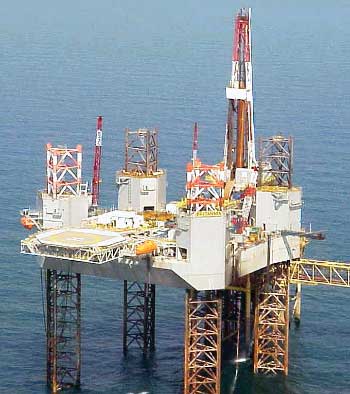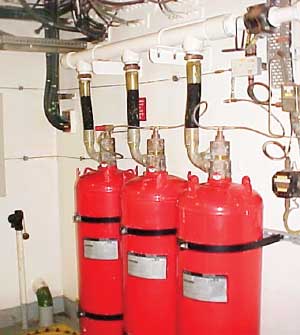Special Focus: HEALTH, SAFETY, ENVIRONMENT
Environment a priority in rig fleet’s fire safety selection
Faced with increasingly tough regulations, drilling company GlobalSantaFe studied many alternatives to find a greener extinguisher system.
Joe Ziemba, 3M
For years the offshore drilling industry has used chemical and inert gases as well as water mist systems as extinguishants for fire protection. However, tightening environmental regulations are compelling companies to find alternative firefighting systems that address the workplace safety and environmental concerns associated with traditional clean agents.
Drilling company GlobalSantaFe studied several potential replacements for its ozone-depleting halon fire-extinguisher systems. The company based its selection on safety, environmental impact, regulatory compliance and fire-fighting effectiveness.
BACKGROUND
The 1987 Montreal Protocol fueled the search for alternatives by mandating that the production and consumption of compounds that deplete the ozone, including halon, be phased out. Additionally, in 2000, the European Parliament and the Council of the European Union banned the use of virgin halon (EC Regulation 2037/2000), except for defined critical uses, including aircraft applications, military applications and specialized inerting applications. As a result, it has become virtually impossible for drilling companies to refill halon systems abroad if they plan to continue to conduct business in European countries.
The uncertain availability of recycled halon is a mounting concern, and the cost to maintain halon-based systems is increasing. Clean agents that have not been targeted for phase-out or emission reduction by these international treaties and are not subject to individual country regulations will provide the most sustainable options to replace halon systems.
PRODUCT SELECTION
In 2004, drilling company GlobalSantaFe (now part of Transocean) decided to address the increasingly tough regulatory, environmental and worker safety issues. The Houston-based company, which contracts a fleet of 59 mobile offshore rigs to oil and gas companies worldwide, commissioned an internal task force to determine the best replacement for the halon fire extinguishing systems installed aboard 23 vessels in its fleet, Fig. 1. Its selection criteria were based on safety, environmental impact, regulatory compliance and fire-fighting effectiveness. The product alternatives considered by the task force included high-expansion foam, carbon dioxide, water mist, and a number of clean fire-suppression agents such as 3M’s proprietary Novec 1230 fluid, heptaflouropropane (HFC-227, sold by Great Lakes Chemical Corp. as FM-200) and Ansul’s Inergen inert-gas blend.
 |
Fig. 1. The independent-leg cantilever jackup GSF Britannia is one of 23 rigs owned by GlobalSantaFe that used ozone-depleting halon fire-protection systems.
|
|
The task force evaluated information from vendors and manufacturers, in addition to reviewing data and drawings from the rigs involved. After considering all available products, the company determined that Novec 1230 fluid was the best replacement product for its halon systems based on its high margin of safety and its low environmental impact. Additionally, the selected fluid could be more easily refilled onboard than other alternatives, using bulk containers with a low-vapor-pressure liquid, in case the system discharged either accidentally or in a fire.
Ozone depletion potential was not the only issue considered with regard to sustainability. HFC-227 products like FM-200 and DuPont’s FE-227 reside in the atmosphere for years and have Global Warming Potentials (GWPs) ranging from 3,400 to 12,000 times that of CO2. Novec 1230 has an atmospheric life of five days and a global warming potential of 1 (equal to CO2). Based on this, the task force determined that the fluid aligned well with the company’s corporate commitment to worker safety and environmental protection.
Furthermore, the selected fluid complies with all applicable requirements and is certified for use by the vessels’ countries of registration, the US Coast Guard, the American Bureau of Shipping and Det Norske Veritas, as well as Underwriters Laboratories and FM Global.
“It has been determined that Novec 1230 fluid is safe for humans at concentrations much higher than what is required for extinguishing fires,” says Mark Dreith, manager of project planning and estimating for GlobalSantaFe. “In our opinion, the wide margin of safety and excellent environmental profile give the product a significant edge over the other alternatives that we explored.”
While the rigs that were fitted with halon systems still met all the current regulatory standards, GlobalSantaFe voluntarily elected to replace its halon systems with a non-ozone-depleting substance that would provide a sustainable technology, Fig. 2.
 |
Fig. 2. On the GSF Britannia and other rigs in its fleet, GlobalSantaFe has begun phasing out its halon fire extinguishers in favor of the non-ozone-depleting alternative.
|
|
OTHER CONSIDERATIONS
The fluid, which is stored as a liquid, becomes a gas upon discharge. It has non-conductive properties, which was a big selling point for GlobalSantaFe because the company could install the systems in engine rooms, SCR rooms, emergency generator rooms, control rooms and paint lockers aboard offshore rigs. Another key benefit was that the fluid leaves no messy residue to clean, so systems can remain operational after discharge. The task force also found that the fluid met all regulatory standards for paint lockers.
Because the fluid has low vapor pressure, it can be shipped in bulk. This makes it “easier to handle and convenient to store so we have the ability to retrofit offshore systems upon discharge without the rig having to return to a shipyard for maintenance,” Dreith says. “All other systems’ bottles physically have to be sent off the rig to be refilled, costing time and money.”
GlobalSantaFe has begun a gradual phase-out of its halon systems. Dreith is confident that the transition will provide both immediate and long-term benefits, allowing the company to meet current environmental regulations and those in the foreseeable future. 
|
THE AUTHOR
|
|
Joe Ziemba is the marketing manager for 3M’s Novec 1230 fire-protection fluid. He has more than 20 years of industry experience and has served on the board of directors of both the Halon Alternatives Research Corporation and the Fire Suppression Systems Association. Before joining 3M, he served as marketing manager for engineered systems at Ansul, Inc., as well as the executive director of the National Association of Fire Equipment Distributors.
|
|
|




